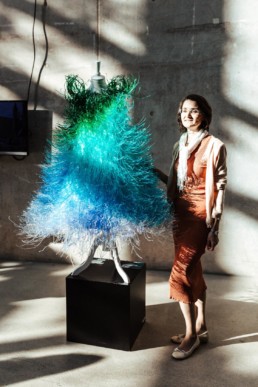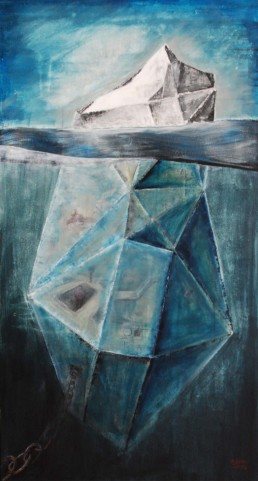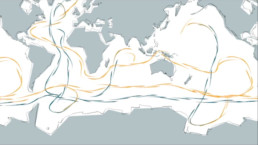The Iceberg
Camilla
When 13-year-old Camilla was a baby, Jaron found her on the beach of Øy. At first, he didn‘t know what to do with her, but he soon realized that Camilla is not only exceptionally smart, but also technically gifted. And so he taught her everything he knew. Everything he didn‘t know, she taught to herself, such as dancing ballet, baking cakes, and designing costumes.
Camilla isn‘t bothered by not knowing her parents. With Jaron around, there was nothing she missed. In the summertime when the island was buzzing with people, she always found someone to play with. Still, the long winter months were a lonesome time for her. Now that Jaron has been missing for a year, they are even more lonely. Due to her endearing, sometimes naive view on the world, Camilla underestimates some problems. Yet at the same time, her naivety is a gift that enables her to quickly come up with simple solutions as there are no barriers limiting her thinking. To solve a structural design problem, she invents a device reversing the laws of structural engineering – simple as that.
Listen to the audio book part 2
Artistic Research: Reflections about Water
Results from the International Masterclass Artistic Research:
Transmedia Storytelling - Camilla Plastic Ocean Plan at Filmuniversity Babelsberg 2019
SHOW US YOUR OWN IDEAS ON INSTAGRAM OR VIA EMAIL (max 10mb)
Collaboration withthe Alfred Wegener Institute,Helmholtz Center forPolar and Marine Research
We are a team of artists, researchers, thinkers, and makers
The Alfred Wegener Institute (AWI) of the Helmholtz Center for Polar and Marine Research contributes to the ‘Camilla Plastic Ocean Plan’ research project as partner. The AWI explores both climate change in general and, in particular, the issue of plastic pollution in the Arctic deep sea and the North Sea.
Contact persons for the project are Dr. Lars Gutow (Bremerhaven) and Prof. Dr. Bernhard Diekmann (Potsdam).
Prof. Dr. Bernhard Diekmann
holds a Diplom and a PhD degree and is an adjunct professor of geology. In April 2005, he was appointed Head and Representative of the Potsdam Research Unit of the Alfred Wegener Institute (AWI), Helmholtz Center for Polar and Marine Research.
A geoscientist with many years of experience, Diekmann has conducted research on past climate changes in the Alpine region, East Africa, the Antarctic Ocean, Siberia, and the Tibetan Plateau. He has participated in more than 20 land and sea expeditions, in 14 of which he served as expedition leader.
Kooperation mitAlfred-Wegener-Institut,Helmholtz-Zentrum fürPolar- und Meeresforschung
Wir sind ein Team aus Künstler*Innen, Wissenschaftler*Innen, Denker*Innen und Praktiker*Innen
Im Forschungsprojekt „Camilla Plastic Ocean Plan“ ist das Alfred-Wegener-Institut für Polar- und Meeresforschung (AWI) als Kooperationspartner eingebunden. Das AWI befasst sich generell mit dem Umweltwandel in den polaren Meeren und speziell mit Plastikmüll in der arktischen Tiefsee und in der Nordsee.
Ansprechpartner sind Dr. Lars Gutow (Bremerhaven), Prof. Dr. Bernhard Diekmann (Potsdam).
Prof. Dr. Bernhard Diekmann
ist promovierter und habilitierter Diplom-Geologe. Seit April 2015 ist er Leiter und Repräsentant der Forschungsstelle Potsdam des Alfred-Wegener-Instituts Helmholtz-Zentrum für Polar- und Meeresforschung (AWI).
Er verfügt über eine langjährige Erfahrung als Geowissenschaftler und befasste sich vor allem mit dem Klimawandel der Vergangenheit im Alpenraum, in Ostafrika, im Antarktischen Ozean, in Sibirien und auf dem tibetischen Hochland. Herr Diekmann hat an mehr als 20 Land- und Schiffs-Expeditionen teilgenommen, davon 14 Kampagnen in leitender Funktion.
Photo: Gerhard Westrich
Interview with Prof. Dr. Bernhard Diekmann
Interview mit Prof. Dr. Bernhard Diekmann
Mini lectures about Ocean & Climate

Art for FutureSa 30.5.202015 – 18:30 Uhr
Ein Programm in 5 Akten mit Filmpremiere, Ausstellungseröffnung, Präsentationen und Workshops im Rahmen des for-futures-summits 2020
Können wir uns Zukünfte vorstellen, die dem Gemeinwohl und der Regeneration des Planeten dienen? Welche Narrative und Bilder können wir entwickeln, um unsere Vorstellungen zu teilen? Wie können wir Synergien kreieren, um gemeinsam zu wirken? Welche Stories wollen wir erzählen, um uns mit der Natur zu verbinden und sie besser wertzuschätzen? Welche Strategien können wir entwickeln, um gemeinschaftlich Verantwortung zu übernehmen hinsichtlich eines ressourcenschonenden Umgangs z.B. von Erdöl oder Plastik?






















